Klue Compete
The Competitive Enablement Platform
Learn More
FIND OUT MORE >

This is a transcript from our recent webinar “How to Build Battlecards Salespeople Love”. You can watch it on-demand here.
If reps are consistently using your battlecards, it’s strong indicator that they love them.
And that usually means better win rates, bigger average deal size, and shorter sales cycles.
But how do you build sales battlecards your reps love in the first place?
Battlecards started as a single-sided piece of paper that salespeople could post in their cubicles as a cheat sheet in competitive deals.
Over time, there was more information to share, so they took over both sides of that piece of paper.
Then they were laminated and designed to look fancy. And somewhere along the way, they turned into 100-slide decks, that sit on network drives and are viewed by no one.
No view means no love.


So let’s think back to what a battlecard was intended to achieve.
Battlecards are meant to contain short, easy-to-use tactics to help sales reps to sell against competitors.
At the most basic level, battlecards serve to help your reps answer the question…


If I picked you out of the audience right now and asked, “how do you compare to your competitors?” or “how are you different from your biggest competitor?”, what would you say?


You can’t see this, but most of you are looking at me like the fine gentleman you see above.
It’s not an easy question to answer. And it’s the question your salespeople are asked EVERY single day.
Two years ago at Klue, we wanted to get a sense of how our own team was answering this exact question.
We actually had our sales team go through and answer the ‘how are we different’ question.
To be honest, it was shocking how different everyone’s answers were.
It wasn’t just that the answers ranged from totally incoherent rambles to more concise statements.
They had vastly different ideas about who we were and how we should be positioned in the market.
There was no consistency in the story of how we’re different from our competitor.
As a PMM or CI professional this proves how challenging it can be to ensure consistency in how you’re being positioned in the market.
While the answers varied widely, one salesperson rose above the rest. So what was so great about her response?
First, she started with a broad, high-level statement about how our two companies took different approaches to solve the same problem.
Then, she supported that statement with two key points about where we were differentiated. Still – broad and not talking about specific features.
Finally, she wrapped up and summarized again, reinforcing that high-level statement.
She made it memorable by repeating a simple and concise point of view.
And by staying high-level she made it easier to understand how we were different overall.
So how do we take what Erin said, and train our entire sales team to use the same, consistent message?
We use battlecards.
Let’s get some of the obvious rules of how to build battlecards out of the way.
Start thinking about how your content can be built to actually enable your sales reps at each step of the sales cycle.


First, they need to identify if there are competitors in their deal.
Sometimes a prospect will flat out tell them this, but other times they need to listen for clues.
This is something they need to master. The earlier your reps can identify a competitor in a deal, the better opportunity they have to deposition and dismiss them out of it.
If the prospect is actively evaluating your competitor as the deal progresses you need a combination of offensive and defensive tactics to beat them.
For your sales reps, the deeper they get into the deal, the more information they’ll need, but not all at once.
This is called breadcrumbing.
The first step is to provide quick bites of intel as a first step, and then intentionally guide reps deeper and deeper to more information as they need it, not before.
Leading your reps through your content in this way makes it easier for them to digest and is proven to be the most effective.
Some reps will want to jump to feature comparison and pricing information immediately — but if your reps are selling on features — they will always end up in a battle to the lowest price.
Inevitably, competitors will catch up, or possibly surpass your offer. That results in discounts. Prevent this by focusing on high-level depositioning strategies when you are building out your competitive intelligence program.
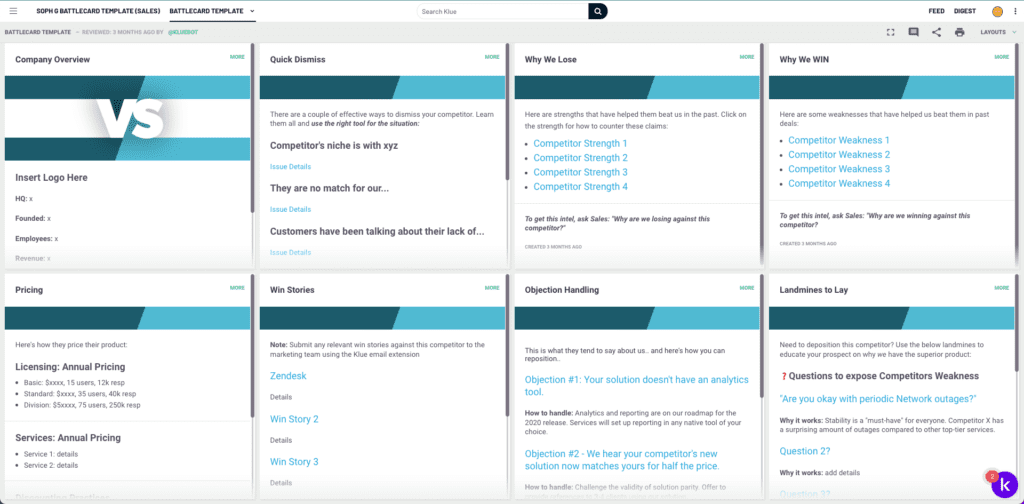

Using this content framework we’ve pulled together the top types of content you can use to build an effective battlecard on any competitor. We’ve also written a blog on these 8 essential battlecards.
1] How do I spot this competitor in a deal? (How to Spot)
So what are the Unique terms, phrases, and language to listen for or questions they can expect to face
2] How do I differentiate from this competitor?
This goes back to the approach that Erin used earlier. What is the high-level summary, what are some supporting points, and how do you summarize that again in a way that is going to be memorable.
You can call this a Quick Dismiss or positioning statement.
3] How do I attack?
4] How do I defend?
There are a number of different tactics that you can use, but you need some combination of offensive and defensive strategies. In this case we’ve used the Questions to Ask and Landmines cards for offensive tactics, and Objection Handling for defense.
5] How do they approach the market? (Approach to Market)
These should be facts. Insights about your competitor’s ideal customer can be used to learn about how they approach the sales process.
Lastly, Why we win/Why we lose cards should include high-level summary points that link out to full customer stories to prevent overloading information in the battlecard itself.
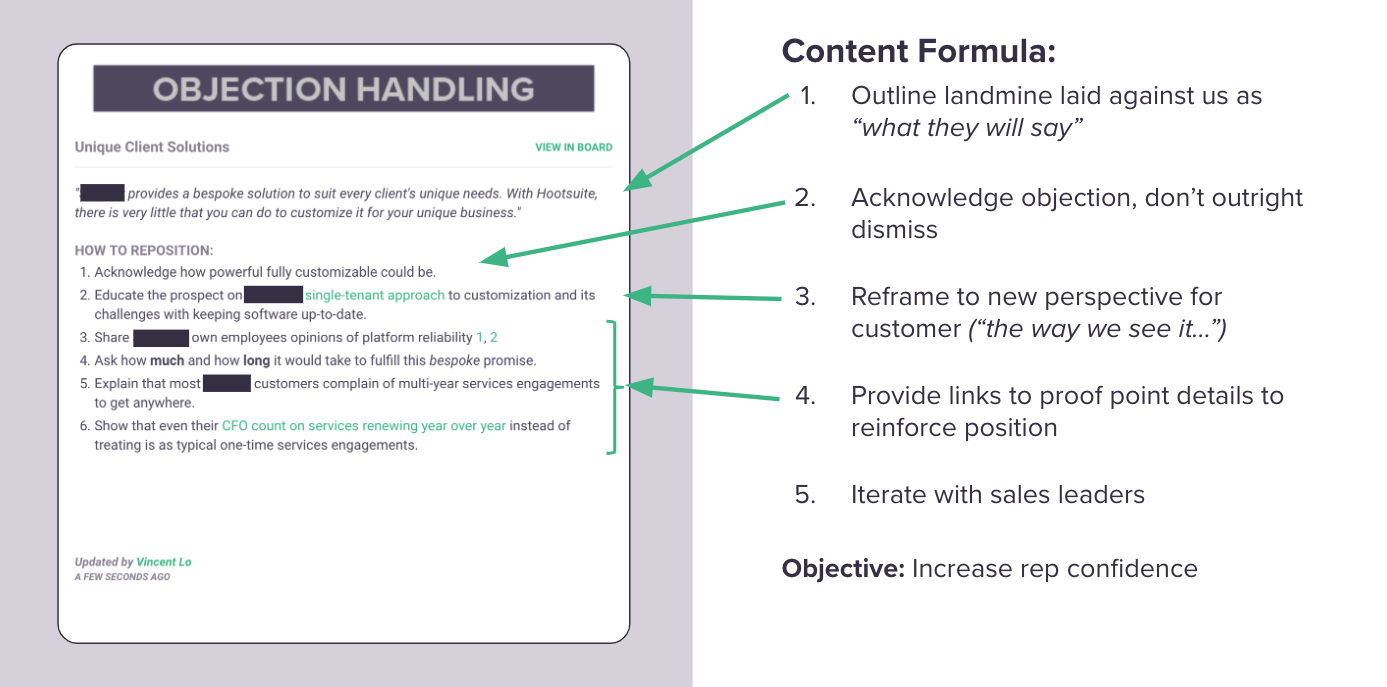

The main point of the objection handling card is to give salespeople a way to respond to the most common objections they can expect to hear when going up against that competitor.
This card is different from the rest in that we’re going to give them talking points rather than the exact words to say.
The reason behind this is that there’s a specific process of handling an objection and it’s not just regurgitating a statement.
Building Objection Handling content is undeniably difficult, but I want to share a tried-and-true 3-step method our team uses to that you can start using when you get back to your offices on Monday:
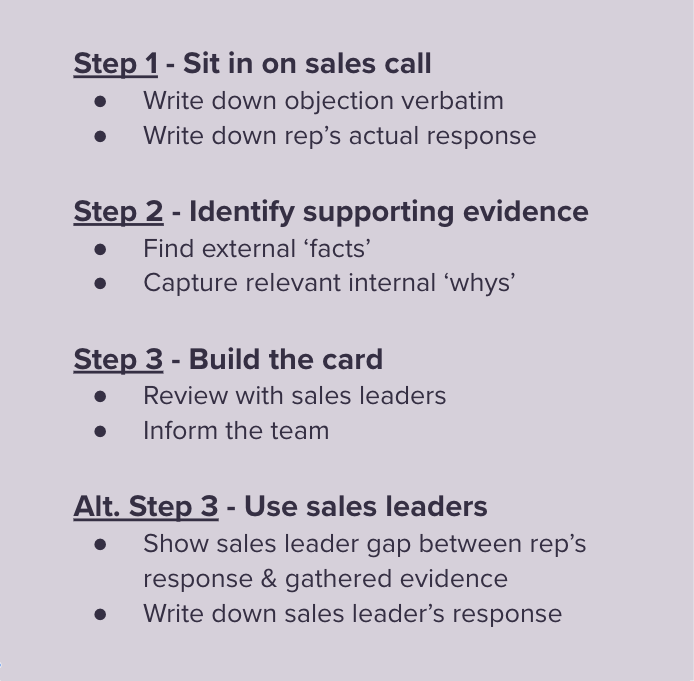

Step 1 – listen in on a sales call; write down the objection verbatim AND write down the rep’s response,
Step 2 – after the call, sit down and identify the facts that support the rep’s response
Step 3 – assuming facts easily support the response, great, we have a winner. Create the objection handling card and refine the response with the reps and sales leaders.
Alternate Step 3 – when the facts don’t support the response, go ask the sales manager for help coming up with a new way to handle the objection. As long as you’re not doing this during the quarter-end, they’re usually more than happy to help.
Ultimately It’s only going to improve their win rates.
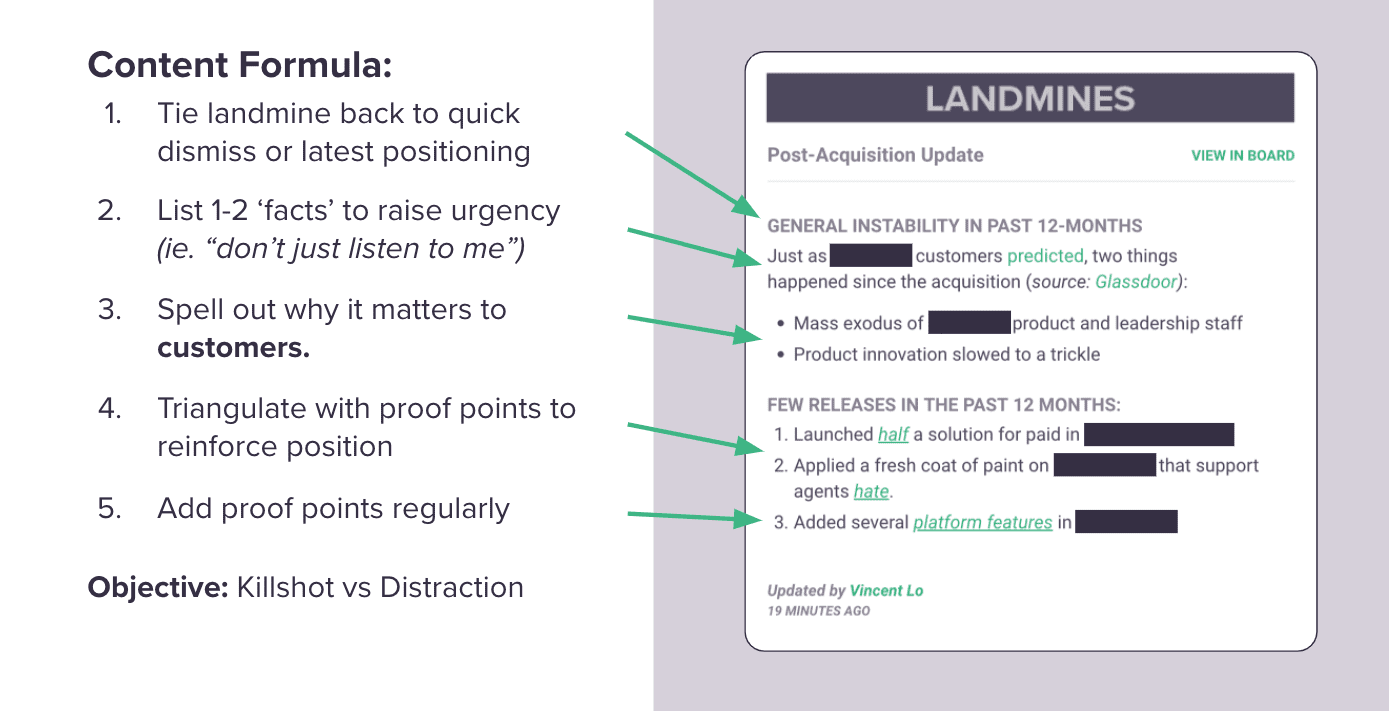

The landmines card is used to plant a seed of doubt into the mind of your prospect about choosing a competitor’s solution.
This is done by asking specific questions or mentioning key points where you know their solution won’t match up with yours.
In an ideal world, your salesperson can use these landmines to blow the competition out of the water, but more often than not, all you’re doing is making the other salesperson dance and expend energy instead of actively selling to the customer — while you do.
These are some of the additional questions we didn’t quite get to during the live webinar. Access the full on-demand recording here to see what other competitive intelligence professionals asked our experts.
Looking for more information on how to build battlecards? Check out our Competitive Battlecards 101 template library.
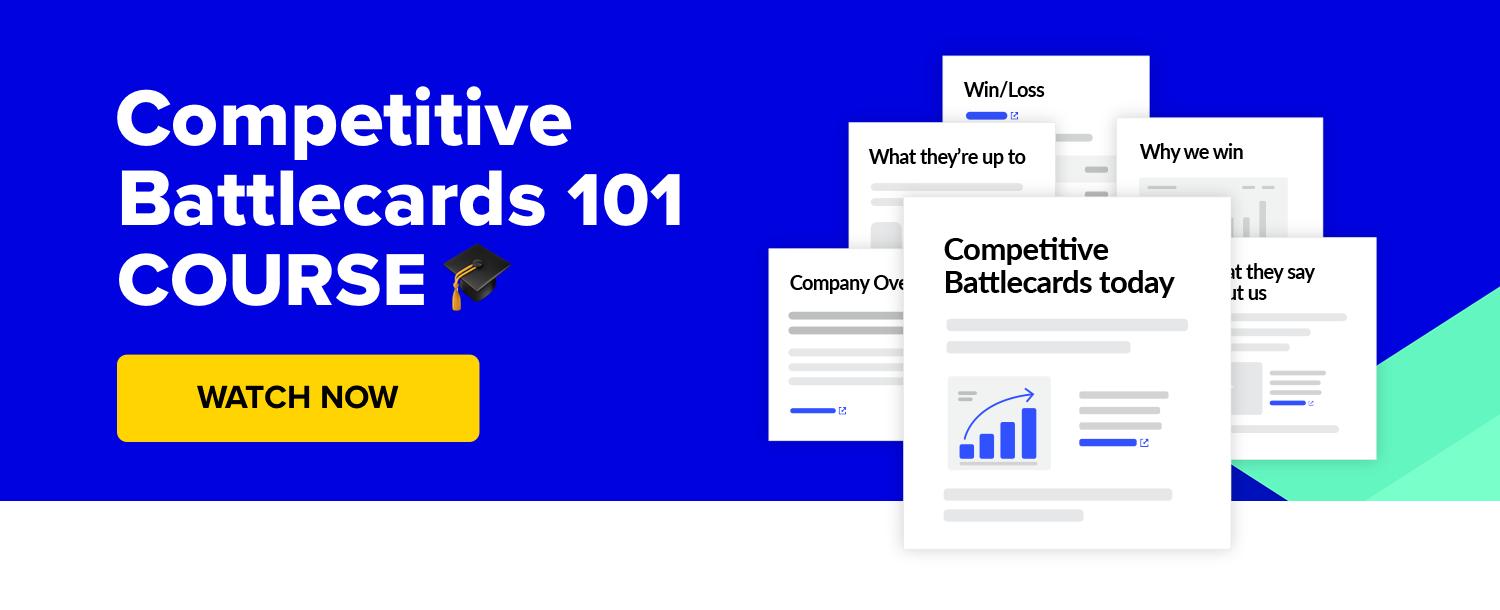



Competitive Enablement
Product marketers conducting competitive research are drowning in reviews, reports, and messy notes. Here's how Klue's AI foundation will help you complete this analysis in seconds, not weeks.


Competitive Enablement
The topic of Large Language Models (LLMs) has a lot of confusion. Here's what you need to know about how Klue is working with them.


Let’s do it. Tell us a bit about yourself and we’ll set up a time to wow you.
Let's do it. Tell us a bit about yourself and we'll set up a time to wow you.
XLet's do it. Tell us a bit about yourself and we'll set up a time to wow you.
XSubscribe to get our latest AI functionality and news in your inbox.
XOur Buyer Pulse feature, set to launch in Q2 2024, offers valuable insights into the factors influencing buyer decisions in your pipeline. By signing up for the waitlist, we can better gauge interest and proactively engage with you to streamline the setup and integration process before the feature becomes widely available.
X